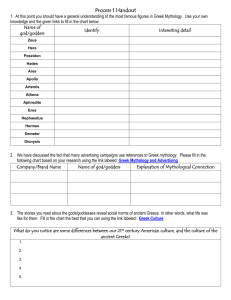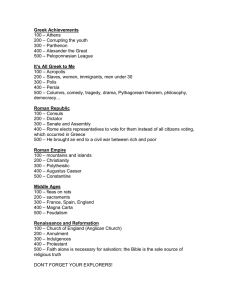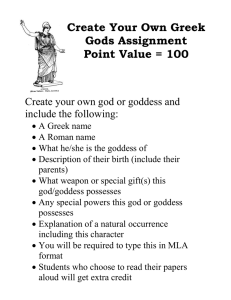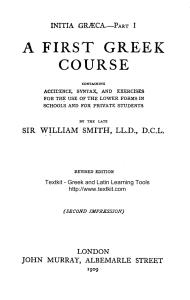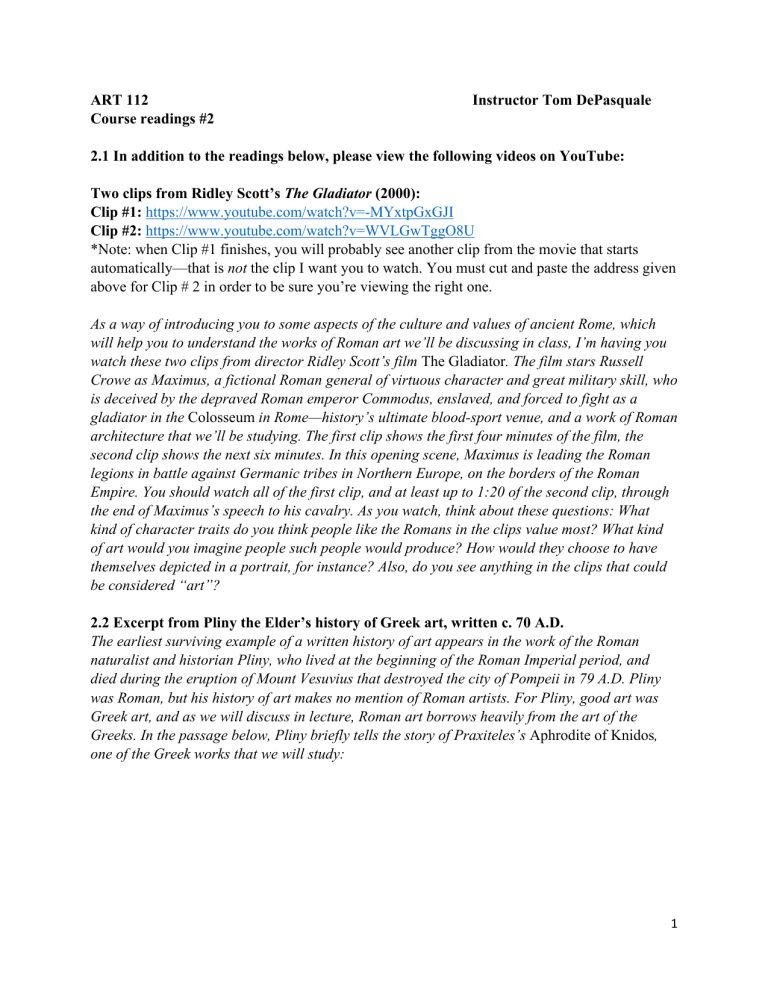
ART 112 Course readings #2 Instructor Tom DePasquale 2.1 In addition to the readings below, please view the following videos on YouTube: Two clips from Ridley Scott’s The Gladiator (2000): Clip #1: https://www.youtube.com/watch?v=-MYxtpGxGJI Clip #2: https://www.youtube.com/watch?v=WVLGwTggO8U *Note: when Clip #1 finishes, you will probably see another clip from the movie that starts automatically—that is not the clip I want you to watch. You must cut and paste the address given above for Clip # 2 in order to be sure you’re viewing the right one. As a way of introducing you to some aspects of the culture and values of ancient Rome, which will help you to understand the works of Roman art we’ll be discussing in class, I’m having you watch these two clips from director Ridley Scott’s film The Gladiator. The film stars Russell Crowe as Maximus, a fictional Roman general of virtuous character and great military skill, who is deceived by the depraved Roman emperor Commodus, enslaved, and forced to fight as a gladiator in the Colosseum in Rome—history’s ultimate blood-sport venue, and a work of Roman architecture that we’ll be studying. The first clip shows the first four minutes of the film, the second clip shows the next six minutes. In this opening scene, Maximus is leading the Roman legions in battle against Germanic tribes in Northern Europe, on the borders of the Roman Empire. You should watch all of the first clip, and at least up to 1:20 of the second clip, through the end of Maximus’s speech to his cavalry. As you watch, think about these questions: What kind of character traits do you think people like the Romans in the clips value most? What kind of art would you imagine people such people would produce? How would they choose to have themselves depicted in a portrait, for instance? Also, do you see anything in the clips that could be considered “art”? 2.2 Excerpt from Pliny the Elder’s history of Greek art, written c. 70 A.D. The earliest surviving example of a written history of art appears in the work of the Roman naturalist and historian Pliny, who lived at the beginning of the Roman Imperial period, and died during the eruption of Mount Vesuvius that destroyed the city of Pompeii in 79 A.D. Pliny was Roman, but his history of art makes no mention of Roman artists. For Pliny, good art was Greek art, and as we will discuss in lecture, Roman art borrows heavily from the art of the Greeks. In the passage below, Pliny briefly tells the story of Praxiteles’s Aphrodite of Knidos, one of the Greek works that we will study: 1 Question: Why, according to Pliny, did the people of the Island of Kos choose the clothed version of the statue? Why does Pliny say the people of Kos made a mistake by not purchasing the nude version? FAMOUS THROUGHOUT THE WHOLE WORLD is the Aphrodite by Praxiteles which multitudes have sailed to Knidos [pronounced “NEED-os”] to look upon. The artist had offered two statues of Aphrodite for sale at the same time, one was clothed, the other nude; the price of the two figures was the same. The people of the island of Kos were given their choice between the two, and they chose the clothed figure, flattering themselves by thinking they would be admired for their severe modesty. But the rejected statue, which was bought by the people of Knidos, enjoys an immeasurably greater reputation. King Nikomedes subsequently wished to buy it from them, offering to pay off all the public debt of the city of Knidos, which was enormous. The people of Knidos, however, preferred to suffer the worst that could befall, and they showed their wisdom, for in time this statue by Praxiteles made Knidos illustrious. 2.3 Excerpt from Lucian’s Erotes (“Loves”), written c. 150 A.D. Lucian was a Greek writer who lived in Anatolia, a province of the Roman Empire located in the region occupied today by Turkey. His book Erotes takes the form of a debate between two speakers on the question of which is more noble and more pleasurable—heterosexual or homosexual love. The Erotes is significant for art history because it contains a detailed account of a visit to the island of Knidos, to the sanctuary of Venus (called Aphrodite by the Greeks), where the famous statue of the goddess by the Greek artist Praxiteles was located (this is the same statue, of course, to which Pliny refers in the passage you just read above). Praxiteles had made the statue almost 500 years before Lucian’s time, and it had become famous throughout the ancient world for its lust-provoking power. Question: In light of the passages we have read from the works of Plato and Aristotle, how do you think each of those authors would respond to 2 the kind of discussion found in Lucian’s Erotes? Specifically, is there anything in Lucian’s text to which Plato or Aristotle might object? WE DECIDED TO ANCHOR at the island of Knidos to see the temple of Aphrodite, which is famed for possessing the most truly lovely example of Praxiteles' skill. As we gently approached the land, I believe that the goddess herself was escorting our ship by providing smooth calm waters. The others occupied themselves with the usual preparations, but I took the two authorities on love [i.e. the narrator’s two friends, Charicles and Callicratidas] , one on either side of me, and went round Knidos, finding no little amusement in the wanton [i.e. lascivious] products of the potters [i.e. makers of ceramic vessels], which reminded me that I was in Aphrodite's city. First we went round the porticos of Sostratus and everywhere else that seemed pleasant to visit and then we walked to the temple of Aphrodite. Charicles and I did so very eagerly, but Callicratidas was reluctant because he was going to see something female, and would have preferred, I imagine, to have had Eros [i.e. Cupid, Aphrodite’s son] of Thespiae instead of Aphrodite of Knidos. And immediately, it seemed, there breathed upon us from the sacred precinct itself breezes filled with love. For the uncovered courtyard was not for the most part paved with smooth slabs of stone to form an unproductive area but, as would be expected in Aphrodite's temple, was filled with garden fruits. These trees, luxuriant with fresh green leaves, roofed in the air around them. Though the fruit trees were old in years they were not withered or faded but, still in their youthful prime, swelled with fresh sprays. Intermingled with these were trees that were unproductive except for having beauty, and for towering to the heavens like Daphne, who deserted from Aphrodite and fled from that goddess long ago. But around every tree crept and twined the ivy, devotee of love. Rich vines were hung with their thick clusters of grapes. For Aphrodite is more delightful when accompanied by Dionysus and the gifts of each are sweeter if blended together, but, should they be parted from each other, they afford less pleasure. [Lucian is describing here the way in which the plants and various things in the temple reflect the theme of love. Note how the poetic, metaphorical style of Lucian’s language allows him to convey ideas that would sound less polite if stated literally: for instance, his point in referring to the grapes, and Aphrodite and Dionysus, is that sexual activity is more pleasurable when one has consumed wine, and is thus intoxicated.] Under the particularly shady trees were joyous couches for those who wished to feast themselves there. These were occasionally visited by a few upper-class folk, but on holidays the masses flocked there to pay homage to Aphrodite. When the plants had given us pleasure enough, we entered the temple. In the midst thereof stands the goddess—she's a most beautiful statue of marble—arrogantly smiling a little as a grin parts her lips. Draped by no garment, all her beauty is uncovered and revealed, except in so far as she unobtrusively uses one hand to hide her private parts. So great was the power of the craftsman's art that the hard unyielding marble did justice to every limb. Charicles at any rate raised a mad distracted cry and exclaimed, "Happiest indeed of the gods was Ares, who suffered chains because of her!" [according to a story in Greek mythology, Aphrodite’s husband Hephaistos once caught Ares (the god of war) in bed with Aphrodite, tied them up in chains and paraded 3 them around to humiliate them.] And, as he spoke, he ran up and, stretching out his neck as far as he could, started to kiss the goddess with importunate lips. Callicratidas stood by in silence. The temple had a door on both sides for the benefit of those also who wish to have a good view of the goddess from behind, so that no part of her be left unadmired. It's easy therefore for people to enter by the other door and survey the beauty of her rear. And so we decided to see all of the goddess and went round to the back of the precinct. Then, when the door had been opened by the woman responsible for keeping the keys, we were filled with an immediate wonder for the beauty we beheld. The Athenian Callicratidas who had been so impassive an observer a minute before, upon inspecting those parts of the goddess which recall a boy, suddenly raised a shout far more frenzied than that of Charicles. "Heracles!" he exclaimed, "what a well-proportioned back! What generous flanks she has! How satisfying an armful to embrace! How delicately molded the flesh on the buttocks. And as for those precious parts sealed in on either side by the hips, how inexpressibly sweetly they smile! How perfect the proportions of the thighs and the shins as they stretch down in a straight line to the feet! So that's what Ganymede looks like as he pours out the nectar in heaven for Zeus and makes it taste sweeter.” [Ganymede was a young male human with whom Zeus, king of the Greek gods, fell in love] While Callicratidas was shouting this under the spell of the goddess, Charicles in the excess of his admiration stood almost petrified, though his emotions showed in the melting tears trickling from his eyes. 2.4 Excerpt from the Gospels of Matthew (The New Testament), written c. 50 AD The following passages were written by Matthew, one Jesus of Nazareth’s twelve original followers, who collectively are called the “apostles”, a term deriving from the Greek word apostolos, meaning “messenger”. In the passages, Matthew sets out several of the central ideas and convictions of the Christian religion, which will serve as points of reference for our discussion of Christian art over the next several weeks. To get started, read the passages from Matthew’s Gospel, and consider this question: how do the ideas articulated here relate to concepts and themes we’ve addressed in our discussions of art—Egyptian and Greek—up to this point? How do they relate to morality and mysticism? Social class? Beauty? AT THE END OF TIME, Christ will divide all people into two groups. He will put the righteous people on his right side and the others on his left. Then he will say to those on his left, “Away from me, you that are under God's curse! Away to the eternal fire which has been prepared for you! For I was hungry but you would not feed me, thirsty but you would not give me a drink; I was sick and in prison but you would not take care of me.” Then they will answer him, “When, Lord, did we ever see you hungry or thirsty, or sick or in prison, and did not help you?” Then Christ will reply, “I tell you, whenever you refused to help the humblest and least important person, you refused to help me. You, then, will be sent off to eternal punishment, but the righteous will go to eternal life.” 4 Jesus said to them, “It is easier for a camel to go through a needle's eye, than for a rich man to enter into the kingdom of Heaven.... Many shall be last who are now first, and many who are now last shall be first….” And Jesus said, “You have heard that it was said to those of old, ‘You shall not commit adultery.’ But I say to you that whoever even looks at a woman with lust for her has already committed adultery with her in his heart. If your right eye causes you to sin, pluck it out and cast it from you, for it is more profitable for you that one of your members perish than for your whole body to be cast into hell.” 2.5 Excerpt from Saint Augustine’s City of God, written c. 400 AD In the follow passage, Augustine, a Christian saint and one of the most important early Christian theologians, gives a lesson about the relationship between human nudity and morality. The lesson is based on Augustine’s analysis of the story of Adam and Eve, who, according to the Book of Genesis (the first part of the Old Testament of the Bible), were the first man and woman, from whom all other humans are descended. According to Genesis, Adam and Eve were created “in God’s image,” and lived with God in paradise, but they soon disobeyed the one rule God had set out for them—they ate the fruit of the “tree of knowledge of good and evil.” Questions to think through: what effect did this disobedience have on the moral status of human nudity? On the basis of Augustine’s attitude toward nudity, what differences might you expect to find between art of the Greco-Roman tradition and Christian art? How do you think Augustine would feel about the passage you just read above from Lucian’s Erotes? Justly is shame very specially connected with sexual desire; justly, too, these members [the genitals] themselves, being moved and restrained not at our will, but by a certain independent autocracy, so to speak, are called shameful. Their condition was different before the first sin of Adam and Eve. For it is written in the Book of Genesis that Adam and Eve “were naked and were not ashamed.” Not because their nakedness was unknown to them, but because nakedness was not yet shameful, because not yet did lust move those members without the will's consent; not yet did the flesh by its disobedience testify against the disobedience of man. [So, when Adam and Eve ate the forbidden apple, their nude bodies became shameful and sinful, which they hadn’t been when God first created them] Their eyes were open, but were not open to this, that is to say, they did not recognize what was conferred upon them by the garment of grace, for they had no consciousness of their members warring against their will. [“Garment of grace” is Augustine’s metaphor for the state of innocence and purity in which the bodies of Adam and Eve existed before the Fall—although they wore no clothes, they were “clothed” by God’s grace, God’s holiness] But when they were stripped of this grace, there began in the movement of their bodily members a new shamelessness which made nakedness indecent, so that their disobedience might be punished by just retribution: it at once made them observant and made them ashamed [that is, they saw that they were nude, and were immediately ashamed of it]. And therefore, after they violated God's command by open transgression, it is written: “And the eyes of them both were opened, and they knew that they were naked; and they sewed fig leaves together, and made themselves aprons.” [Genesis 3:7] The eyes of them both were opened, not to see—for already 5 they saw—but to discern between the good they had lost and the evil into which they had fallen. And therefore also the tree itself which they were forbidden to touch was called the tree of the knowledge of good and evil from this circumstance, that if they ate of it, it would impart to them this knowledge. For only the discomfort of sickness reveals the pleasure of health. They knew, therefore, that they were naked, deprived of that holy grace which prevented them from being ashamed of bodily nakedness while the law of sin offered no resistance to their mind. And thus they obtained a knowledge of which they would have lived in blissful ignorance, had they obeyed God and declined to commit that offense which involved them in the experience of the hurtful effects of unfaithfulness and disobedience. And therefore, being ashamed of the disobedience of their own flesh, which witnessed to their disobedience while it punished it, they sewed fig leaves together, and made themselves aprons to cover their private parts. Consequently all nations, being descended from Adam and Eve, have so strong an instinct to cover the shameful parts, that some barbarians do not uncover them even in the bath, and choose to wash with their pants on. In the dark solitudes of India also, though some philosophers go naked, and are therefore called gymnosophists, yet they make an exception in the case of these members and cover them. [‘gymnosophists’ is Greek for “nude men of knowledge”; cf. “gymnasium”, Greek for “place of nudity”.] 6



